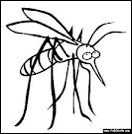The first case of West Nile Virus in Saskatchewan was found Aug. 3, in the Regina Qu'Appelle region.
The infection was detected by Canadian Blood Services when the individual was donating blood.
The majority of people who contract West Nile Virus end up showing no symptoms or mild symptoms like fever, headaches and body aches. In around one per cent of cases, however, West Nile can lead to more serious health effects, such as meningitis (inflammation of the lining of the brain or spinal cord) and encephalitis (inflammation of the brain). Symptoms then include severe headaches, high fever, stiff neck, vomiting, drowsiness, confusion, loss of consciousness, muscle weakness and paralysis. Symptoms in either case can appear two to 15 days after infection.
Though the long-term effects of a West Nile Virus infection are not well understood, it can lead to a variety of physical effects, including long-term muscle weakness and paralysis, fatigue and headache; cognitive effects, including confusion, depression, problems with concentration and memory loss; or functional effects.
Anyone with a weaker immune system, such as the young and the old, are at a greater risk of severe complications, though anyone can experience the serious health effects.
Livestock can also be at risk. Horses and younger domestic birds may die from an infection, and weaning pigs have been shown to be susceptible. Dogs and cats rarely show symptoms.
People and other large hosts become infected after being bitten by an infected mosquito. The mosquitoes become infected after biting a bird with the virus. Once infectedpeople and other mammals are considered "dead-end hosts" for the virus. This means that the virus cannot be transmitted from a human or other mammal to another host by a mosquito. In almost all cases, the only way a virus can go from a human to another host is through the blood, but the risk from both blood transfusions and organ transplants is extremely low. Otherwise, there is some evidence that West Nile Virus can be transmitted through breast milk.
Conditions in Saskatchewan have created excellent breeding grounds for the Culex tarsalis mosquitos that can carry the virus, and so the general public is urged to take precaution. To reduce the risk of exposure, people across Saskatchewan are encouraged to use insect repellent containing DEET, wear light-coloured, loose clothing, reduce time outdoors between dusk and dawn and keep screens on windows and doors in good repair. Because mosquitoes like to rest in long grass and sheltered shady areas, residents are also encouraged to regularly cut their grass and trim hedges and trees around doorways and outdoor seating areas.
People can also help eliminate breeding grounds for the mosquitoes by regularly cleaning and emptying out containers that collect water like bird baths, eavestroughs and old tires and by ensuring rain barrels are covered with mosquito screening or are tightly screened around the downspout.
For information about West Nile Virus in Saskatchewan, including risk maps, surveillance results and Weekly West Nile and Culex Reports, visit www.health.gov.sk.ca/west-nile-virus




